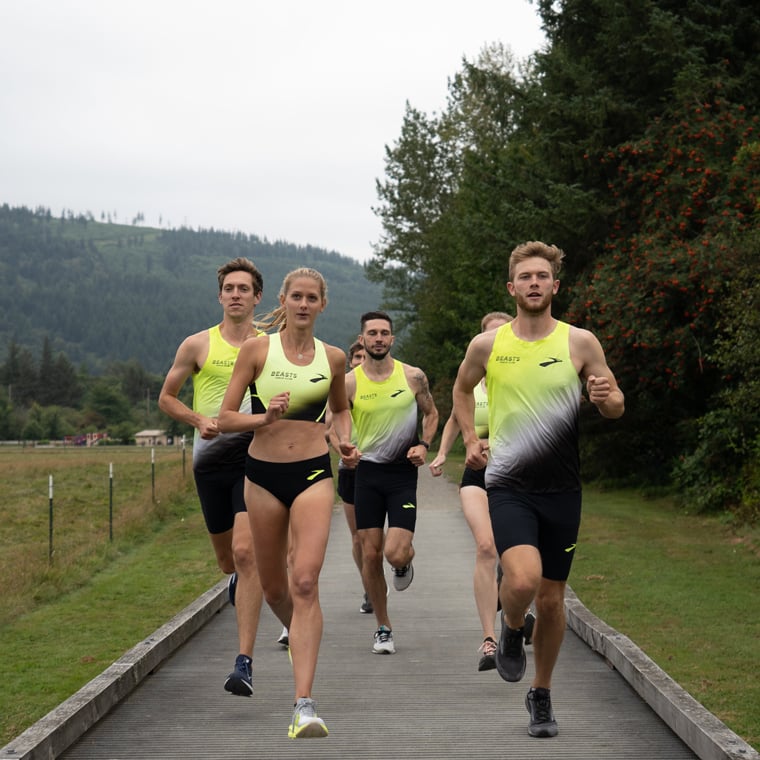The 10K training plans for beginner and advanced runners

Brooks Beast Team

You’re not quite ready to jump into training for your first marathon, but maybe you’re eager for something that requires more endurance than a 5K. Consider the 10K — a popular Goldilocks race that attracts a wide spectrum of runners. At 6.2 miles, the 10K is just right for many — it's a faster pace than a marathon but more challenging than a 5K.
No matter your experience, a 10K training schedule can help you meet your goals. Especially when you've mastered the 5K training plan and need a new challenge. Danny Mackey, coach of our Brooks Beasts pro team, created 10K training plans for beginner and advanced runners. So yeah, these plans are legit. We will also provide you some 10K running tips to get you started.
Following a good training plan for the 10K will fine tune your body for race day, help keep you from getting injured, and push you to run your best time.
How to train for 10k run as a beginner or advanced runner
Our 10k training plan includes all the sessions you'll need to do for a nine-week period.
Some people (new and experienced runners alike) make the mistake of just doing all of their runs at the same pace. But if you do this, you run the risk (pun intended) of doing what's often called 'junk miles'. That means running for the sake of running, without any purpose. If you run too many junk miles, then you might not see much progress over time. That's why we include a mixture of easy-paced runs, tempo runs and speed sessions, to help improve your stamina and speed over the course of your training plan.
If you want to make the most of your training, it's a good idea to have a look at your lifestyle in general, which means having the proper gear for running, eating the right food, and getting enough rest. We're not saying that running needs to take over your life. It's supposed to be fun, after all! But you'll enjoy the process more and get a better result if you're fuelling your body properly, warming up and cooling down properly, and wearing the right gear.
So, with that in mind, here's everything you need to know about how to train for a 10k run as a beginner!
Best gear and running shoes for 10K
If this your first race or your 50th, the same basic training principles apply. Be sure to answer these questions before you get started: Do you have proper equipment for training and race day? What does your nutrition plan look like? How will you stay accountable for your training goals?
First, let’s talk gear. If you’re new to running, you’ll want to find the right shoe for you (hint: they’re not flip-flops). Our Shoe Finder can help match you with the best running shoes for a 10K. If you’re a seasoned runner, you may already have a great fit, but it doesn’t hurt to take the quiz to make sure you’re not missing out on something new.

Shoes aren’t the only pieces of gear that should be top of mind. Do you have the right run bra for training and race day? Our Bra Finder can help!
Read how choosing the correct bra could mean the difference between a comfortable run and a distracted race.
And don’t forget about clothing — good essentials will keep you cool, relaxed and focused on the finish line.
No matter your choice of gear, it’s important to remember to be consistent with what you wear during training. Stick to what works for you and don’t wear something new or unfamiliar on race day – that counts for clothes, technology or shoes. Your un-chafed body will thank you later.
Best food to eat during a 10k training plan
Just as important as what you wear on your body is what you put in it for fuel. It’s not a great idea to scoff a couple of slices of pepperoni pizza before a workout, no matter how good you feel about your impending calorie burn. But what is best to eat before a 10K run? Like most things in life, balance is key when it comes to diet. Use your training time to listen to your body and make small, smart adjustments when you need to. A balanced diet of carbohydrates, protein and good fats is just as much about fuelling your run as it is about keeping gastrointestinal stress in check while you’re active. And of course, don’t forget to drink plenty of water and stay hydrated.

10K beginner running plan tips
Training for any race is no small feat so it’s important to stay accountable. Unless you’re Bear Grylls surviving on a deserted island, you’re not alone — rely on relationships with other runners to keep on top of your 10K training programme. Share your daily training regimen on social media or through run tracking apps like Strava to stay focused and motivated.
With these basics covered, it’s time to get to the nitty gritty of our 10K training programmes.
The 10K beginners training plan
The 9-week training plan for 10K beginners uses the Hansons Training Pace Calculator to figure out your goal finish time, your goal pace (GP), or the speed you’re hoping to maintain during your race), the length of your long run, and the 10K pace for your workouts.
If you’re new to running, don’t let some of the lingo in the 10K training plan for beginners throw you for a loop. Here are some quick definitions:
Goal pace: the speed you’re hoping to maintain during your race
Tempo: in this plan, it means you’ll have difficulty making conversation while running, but should be able to keep up the pace for 45 minutes
Warm-up/cool-down: the runs you do before/after a training session to prep your body for exertion/return your body to rest
Cross-train: non-running exercises like yoga, cycling, swimming, or other low impact activity
Notations: in this training plan, minutes are denoted using single quotation marks (5’ = 5 minutes) and seconds are denoted using double quotation marks (30” = 30 seconds)
For more running lingo definitions, check out our useful glossary.
Advanced 10K running plan
This is a 9-week 10K training plan for advanced runners. Expect a mix of easy runs to start your week (varying from 4 to 7 miles week to week) followed by intense hill work, fast intervals, and long runs. Run a 2-mile warm-up and 2-mile cool-down on Tuesday and Thursday workouts. During the 9 weeks of this advanced 10K training plan, the Sundays are for rest or cross-training.
Running faster after the 10k running plan
The only way to get faster is to run faster. We know what you’re thinking: if it were that easy, you’d already be doing it. Right? Well, we don’t mean that you should simply go out there and improve your 10k time right off the bat. Rather, by incorporating speed sessions into your training, you’ll gradually improve your speed and stamina resulting in your running a faster 10k.
Interval training comes in a variety of different guides, and are typically done at race pace or faster. We recommend incorporating a variety of different speed sessions into your training to keep your routine varied and fun. You could try track sessions, hill repeats, fartleks or sustained effort tempo runs - and luckily, we’ve incorporated plenty of variety into our 10k training plan, including tempo runs and interval training. So, again, if you’re wondering how to run 10k faster, the answer is simply: include faster runs in your training, and you should reap the benefits come race day.
If you’re ready to cut some serious time off your personal best, follow this plan to maximise speed, strength and endurance.